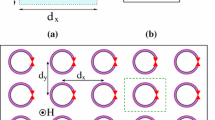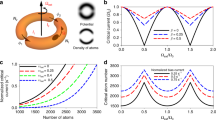Abstract
In the customary mode of operation of a SQUID, the electromagnetic field in the SQUID is an oscillatory function of time. In this situation, electromagnetic radiation is emitted and couples to the sample. This is a back action that can alter the state that we intend to measure. A circuit that could perform as a stationary SQUID consists of a loop of superconducting material that encloses the magnetic flux, connected to a superconducting and to a normal electrode. This circuit does not contain Josephson junctions, or any other miniature feature. We study the evolution of the order parameter and of the electrochemical potential in this circuit; they converge to a stationary regime, and the voltage between the electrodes depends on the enclosed flux. We obtain expressions for the power dissipation and for the heat transported by the electric current; the validity of these expressions does not rely on a particular evolution model for the order parameter. We evaluate the influence of fluctuations. For a SQUID perimeter of the order of 1\(\mu \)m and temperature \(0.9T_c\), we obtain a flux resolution of the order of \(10^{-5}\Phi _0/\)Hz\(^{1/2}\); the resolution is expected to improve as the temperature is lowered.






Similar content being viewed by others
References
C.P. Foley, H. Hilgenkamp, Supercond. Sci. Technol. 22, 064001 (2009)
W. Wernsdorfer, Supercond. Sci. Technol. 22, 064013 (2009)
C. Granata, A. Vettoliere, Phys. Rep. 614, 1 (2016)
E.M. Levenson-Falk, N. Antler, I. Siddiqi, Supercond. Sci. Technol. 29, 113003 (2016)
M.J. Martínez-Pérez, D. Koelle, in Superconductors at the Nanoscale, ed. by R.Wördenweber, V. Moshchalkov, S. Bending, F. Tafuri (De Gruyter, Berlin, 2017); arXiv:1609.06182
W. Wernsdorfer, D. Mailly, A. Benoit, J. Appl. Phys. 87, 5094 (2000)
C.H. van der Wal, A.C.J. ter Haar, F.K. Wilhelm, R.N. Schouten, C.J.P.M. Harmans, T.P. Orlando, S. Lloyd, J.E. Mooij, Science 290, 773 (2000)
J.-P. Cleuziou, W. Wernsdorfer, V. Bouchiat, T. Ondarçuhu, M. Monthioux, Nat. Nanotechnol. 1, 53 (2006)
R. Russo, C. Granata, E. Esposito, D. Peddis, C. Cannas, A. Vettoliere, Appl. Phys. Lett. 101, 122601 (2012)
D. Hazra, J.R. Kirtley, K. Hasselbach, Appl. Phys. Lett. 104, 152603 (2014)
A.G.P. Troeman, H. Derking, B. Borger, J. Pleikies, D. Veldhuis, H. Hilgenkamp, Nano Lett. 7, 2152 (2007)
L. Hao, J.C. Macfarlane, J.C. Gallop, D. Cox, J. Beyer, D. Drung, T. Schurig, Appl. Phys. Lett. 92, 192507 (2008)
L. Hao, J.C. Gallop, D.C. Cox, J. Chen, IEEE J. Sel. Top. Quantum Electron. 21, 1 (2015)
A. Finkler, Y. Segev, Y. Myasoedov, M.L. Rappaport, L. Ne’eman, D. Vasyukov, E. Zeldov, M.E. Huber, J. Martin, A. Yacoby, Nano Lett. 10, 1046 (2010)
A. Finkler, D. Vasyukov, Y. Segev, L. Ne’eman, E.O. Lachman, M.L. Rappaport, Y. Myasoedov, E. Zeldov, M.E. Huber, Rev. Sci. Instrum. 83, 073702 (2012)
D. Vasyukov, Y. Anahory, L. Embon, D. Halbertal, J. Cuppens, L. Neeman, A. Finkler, Y. Segev, Y. Myasoedov, M.L. Rappaport, M.E. Huber, E. Zeldov, Nat. Nanotechnol. 8, 639–644 (2013)
L. Embon, Y. Anahory, Ž.L. Jelić, E.O. Lachman, Y. Myasoedov, M.E. Huber, G.P. Mikitik, A.V. Silhanek, M.V. Milošević, A. Gurevich, E. Zeldov, Nat. Commun. 8, 85 (2017)
F. Giazotto, J.T. Peltonen, M. Meschke, J.P. Pekola, Nat. Phys. 6, 254 (2010)
R.N. Jabdaraghi, M. Meschke, J.P. Pekola, Appl. Phys. Lett. 104, 082601 (2014)
A. Ronzani, C. Altimiras, F. Giazotto, Phys. Rev. Appl. 2, 024005 (2014)
A. Lupaşcu, E.F.C. Driessen, L. Roschier, C.J.P.M. Harmans, J.E. Mooij, Phys. Rev. Lett. 96, 127003 (2006)
M. Hatridge, R. Vijay, D.H. Slichter, J. Clarke, I. Siddiqi, Phys. Rev. B 83, 134501 (2011)
J. Berger, J. Phys. Condens. Matter 29, 29LT01 (2017)
K. Yu. Arutyunov, T.T. Hongisto, Phys. Rev. B 70, 064514 (2004)
S. Guéron, doctoral thesis submitted to University of Paris 6 (1997), http://iramis.cea.fr/drecam/spec/Pres/Quantro/static/publications/phd-theses/index.html; H. Pothier, S. Guéron, D. Esteve, and M. H. Devoret, Phys. Rev. Lett. 73, 2488 (1994). See also V. T. Petrashov, V. N. Antonov, P. Delsing and T. Claeson, Phys. Rev. Lett. 74, 5268 (1995)
A.K. Geim, S.V. Dubonos, J.G.S. Lok, I.V. Grigorieva, J.C. Maan, L.T. Hansen, P.E. Lindelof, Appl. Phys. Lett. 71, 2379 (1997)
V.V. Khotkevych, M.V. Milošević, S.J. Bending, Rev. Sci. Instrum. 79, 123708 (2008)
L. Thiel, D. Rohner, M. Ganzhorn, P. Appel, E. Neu, B. Müller, R. Kleiner, D. Koelle, P. Maletinsky, Nat. Nanotechnol. 11, 677 (2016)
G.R. Berdiyorov, M.V. Milošević, F.M. Peeters, Phys. Rev. B 81, 144511 (2010)
A.A. Burlakov, V.L. Gurtovoi, S.V. Dubonos, A.V. Nikulov, V.A. Tulin, Pis’ma Zh. Eksp. Teor. Fiz. 86, 589 (2007). [JETP Lett. 86, 517 (2007)]
A.A. Burlakov, V.L. Gurtovoi, A.I. Il’in, A.V. Nikulov, V.A. Tulin, Pis’ma Zh. Eksp. Teor. Fiz. 99, 190 (2014). [JETP Lett. 99, 169 (2014)]
N.B. Kopnin, Theory of Nonequilibrium Superconductivity (Clarendon Press, Oxford, 2001)
L. Kramer, R.J. Watts-Tobin, Phys. Rev. Lett. 40, 1041 (1978)
R.J. Watts-Tobin, Y. Krähenbühl, L. Kramer, J. Low Temp. Phys. 42, 459 (1981)
J. Berger, Phys. Rev. B 92, 064513 (2015)
G. Richardson, J. Rubinstein, Proc. R. Soc. Lond. A 455, 2549 (1999)
S.B. Kaplan, C.C. Chi, D.N. Langenberg, J.J. Chang, S. Jafarey, D.J. Scalapino, Phys. Rev. B 14, 4854 (1977). [erratum Phys. Rev. B 15, 3567]
L. Parlato, R. Latempa, G. Peluso, G.P. Pepe, R. Cristiano, R. Sobolewski, Supercond. Sci. Technol. 18, 1244 (2005)
J. Rubinstein, P. Sternberg, Q. Ma, Phys. Rev. Lett. 99, 167003 (2007)
P.G. de Gennes, C.R. Acad, Sci. Paris II 292, 279 (1981)
M. Kato, O. Sato, Supercond. Sci. Technol. 26, 033001 (2013)
W.J. Skocpol, M.R. Beasley, M. Tinkham, J. Appl. Phys. 45, 4054 (1974)
D. Hazra, L.M.A. Pascal, H. Courtois, A.K. Gupta, Phys. Rev. B 82, 184530 (2010)
J. Berger, J. Phys. Condens. Matter 23, 225701 (2011)
A. Schmid, Phys. Kondens. Materie 5, 302 (1966). Note that in Eq. (12.3) in Ref. 32, \(\hbar \) was set as 1
Acknowledgements
Numeric evaluations were performed using computer facilities of the Technion—Israel Institute of Technology. The author has benefited from remarks by Michel Devoret and from correspondence with Hugues Pothier.
Author information
Authors and Affiliations
Corresponding author
Appendix A: Energy Balance in a Wire
Appendix A: Energy Balance in a Wire
Our analysis is an adaptation of Schmid’s seminal work [45]. Schmid’s analysis was intended to deal with the case of TDGL, but we will keep our expressions in a form that is valid for whatever evolution of the order parameter.
We initially use the gauge in which the scalar potential \(\varphi \) is zero. In the units defined in Eq. (1), the Ginzburg–Landau energy of a segment of 1D wire of length dx is
The unit of energy is \(t_0\varphi _0j_0\xi ^2 (0)=2\sigma \hbar k_BT_c\xi (0)/\pi e^2\).
Taking the derivative with respect to time we obtain
and substituting \(w(\partial _{tx}^2\psi ^*){\mathcal D}\psi =\partial _x[w(\partial _t\psi ^*){\mathcal D}\psi ]-(\partial _t\psi ^*)[(\partial _xw){\mathcal D}\psi +w\partial _x({\mathcal D}\psi )]\), this becomes

We now switch to the gauge in which A does not depend on time. \(\partial _tA\) is substituted by \(\partial _x\varphi \) and \(\partial _t\psi \) by \(\partial _t\psi +i\varphi \). We obtain
In addition to the Ginzburg–Landau energy, we take into account the electrochemical energy. Assuming electroneutrality, its rate of increment is \(wj\partial _x\varphi \, \hbox {d}x\). Adding this quantity to Eq. (13) and using Eq. (3), the rate of energy change of the segment becomes
We finally note that if the volume density of power dissipation is W, and the energy flow is \(I_\mathrm{E}\), then this rate of change is \(\hbox {d}F_\mathrm{total}/\hbox {d}t=-(Ww+\partial _xI_\mathrm{E})\hbox {d}x\). From here and from Eq. (14) we identify
and
The first term in W is the Joule dissipation, and the second term is due to the relaxation of the order parameter. In the limiting case of TDGL, \(\partial _t \psi =[\epsilon -|\psi |^2- i\varphi +{\mathcal D}^2+(w'/w){\mathcal D}]\psi \) and we recover the result in [45].
Since \(\psi \) and \(\varphi \) are continuous, it follows from Eq. (16) that the constraint \(\sum _{n=1}^3\pm \,{\mathcal D}\psi _n=0\) not only ensures charge conservation at the contacts between the ring and the connectors, but also energy conservation.
Rights and permissions
About this article
Cite this article
Berger, J. The Stationary SQUID. J Low Temp Phys 191, 330–343 (2018). https://doi.org/10.1007/s10909-018-1851-1
Received:
Accepted:
Published:
Issue Date:
DOI: https://doi.org/10.1007/s10909-018-1851-1




